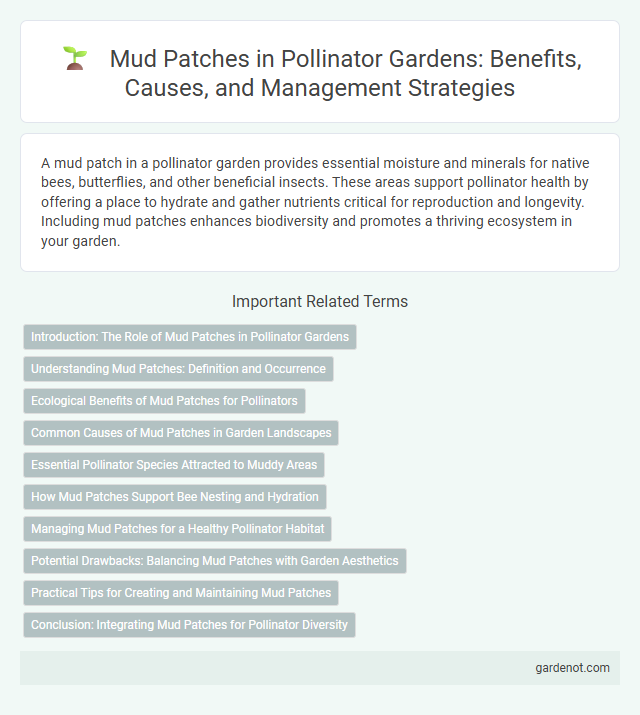A mud patch in a pollinator garden provides essential moisture and minerals for native bees, butterflies, and other beneficial insects. These areas support pollinator health by offering a place to hydrate and gather nutrients critical for reproduction and longevity. Including mud patches enhances biodiversity and promotes a thriving ecosystem in your garden.
Introduction: The Role of Mud Patches in Pollinator Gardens
Mud patches serve as essential microhabitats within pollinator gardens, providing vital resources for ground-nesting bees such as mining bees and sweat bees. These moist, exposed soil areas facilitate nest construction and offer minerals critical for bee development and hydration. Integrating mud patches enhances biodiversity by supporting native pollinator populations and promoting ecological balance.
Understanding Mud Patches: Definition and Occurrence
Mud patches are small, moist areas of exposed soil that provide essential water and minerals for pollinators like bees and butterflies. These patches commonly occur near wetlands, streams, or garden areas with frequent irrigation, offering a critical habitat for hydration and nutrient intake. Understanding the role of mud patches enhances pollinator garden design by promoting biodiversity and supporting native pollinator species.
Ecological Benefits of Mud Patches for Pollinators
Mud patches provide essential habitats for many pollinators such as bees and butterflies by offering a source of moisture and minerals critical for their survival and reproduction. These damp areas facilitate the hydration and nutrient intake necessary for pollinator health, enhancing their ability to pollinate effectively. Furthermore, mud patches support nesting behavior for certain solitary bee species, contributing to increased biodiversity and ecosystem resilience.
Common Causes of Mud Patches in Garden Landscapes
Mud patches in garden landscapes commonly result from poor drainage, compacted soil, and overwatering. Excess water saturates the soil, preventing air circulation and causing persistent wet areas where mud forms. Identifying and improving soil texture, installing proper drainage systems, and adjusting irrigation schedules help mitigate these muddy patches in pollinator gardens.
Essential Pollinator Species Attracted to Muddy Areas
Mud patches attract essential pollinator species such as solitary bees, including mining bees (Andrena spp.) and sweat bees (Halictidae), that rely on moist soil for nesting and hydration. These areas provide critical resources for ground-nesting pollinators, enhancing biodiversity and supporting effective pollination in garden ecosystems. Maintaining mud patches contributes to the survival of key pollinator populations vital for crop and wild plant reproduction.
How Mud Patches Support Bee Nesting and Hydration
Mud patches provide essential resources for ground-nesting bees, offering a moist substrate that facilitates nest construction and structural stability. These patches supply hydration critical for adult bees and larvae development, promoting colony health and reproductive success. By maintaining accessible mud patches, pollinator gardens enhance bee habitat quality and support biodiversity.
Managing Mud Patches for a Healthy Pollinator Habitat
A well-maintained mud patch provides essential nesting sites for solitary bees and ground-nesting pollinators by offering moist, loose soil for burrowing. Regularly monitoring moisture levels and preventing soil compaction ensures the patch remains suitable for pollinator reproduction and larval development. Integrating native vegetation around the mud patch improves soil stability and supports a diverse pollinator community.
Potential Drawbacks: Balancing Mud Patches with Garden Aesthetics
Mud patches in pollinator gardens create essential habitat for ground-nesting bees, but they can clash with traditional garden aesthetics due to their messy appearance. Balancing functionality and visual appeal requires integrating mud patches into naturalistic designs or confining them to discrete areas. Properly managed mud patches promote pollinator health while maintaining overall garden beauty.
Practical Tips for Creating and Maintaining Mud Patches
Creating and maintaining mud patches in pollinator gardens requires selecting a sunny, well-drained spot where water can accumulate temporarily without causing flooding. Use a shallow depression or compacted soil area to retain moisture, and periodically moisten the patch during dry spells to provide a reliable wet surface for mud-puddling pollinators like bees and butterflies. Avoid chemical pesticides near the mud patch to maintain a healthy environment conducive to pollinator hydration and mineral intake.
Conclusion: Integrating Mud Patches for Pollinator Diversity
Integrating mud patches within pollinator gardens enhances habitat diversity by providing essential nesting and moisture resources for solitary bees and other beneficial insects. These natural soil features support successful reproduction and foraging efficiency, ultimately boosting pollinator population stability. Strategic placement of mud patches complements floral diversity, fostering a resilient ecosystem that promotes long-term pollinator health.
Mud patch Infographic

 gardenot.com
gardenot.com